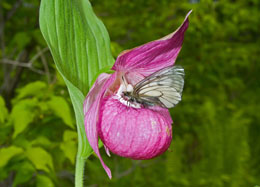Unlike common orchid species, the ground orchid is naturally adapted to ground soil. Growing and caring for this flower is easy, making them a preferred garden plant for hobbyists.

Ground orchid is a perennial orchid variety that grows in the soil. Contrary to this, regular orchids are epiphytes, meaning they absorb water and nutrients from air. Hence, ground orchids are similar in growing habits to terrestrial flowering herbs; whereas their flowers and leaves resemble plants belonging to the
Orchidaceae family. They are best grown in containers for maintaining as houseplants, but can also be planted in garden beds and borders.
A unique feature about this flower is its ability to bloom for an extended period of time if the growth conditions are optimal. It blossoms in all seasons. This variety is available in shades of white, peach, pink, purple, yellow, and magenta. These flowers are of two types, Chinese (
Bletilla hyacinthina) and Malayan (
Spathoglottis plicata). The latter species is more popular in the floral industry, mainly because of its cold hardy nature and long blooming period.
Steps for Caring
The best planting site for this plant is a full sunlit area in colder regions and partially shaded place for warm climatic conditions. Accordingly, select an apt plantation site in your garden. If you are growing it in a container, then the location is not an issue. You can always move a potted plant from sunlight to shade and vice versa. While planting them in garden soil, make sure you maintain a spacing of about 3 - 6 inches between two plants.
Soil Conditions
Enrich the garden soil with a heavy dose of farmyard compost or organic fertilizer. Also supplement broken charcoal, rocks, and bricks to promote healthy growth and spreading of the root system. The ideal soil pH for growing these orchids is mild acidic (pH 6.1) to neutral (pH 7.5).
Watering Frequency
During the growing season, regular watering is a must to induce maximum flower development. Nevertheless, allow the top soil layer to dry between two watering sessions. Heavy watering will cause water logging of the soil. In nature, these plants thrive well in high humidity and moist soil. Hence, you can adjust the soil and growth conditions to mimic their natural habitat.
Adding Fertilizers
Ground orchids require less efforts and care as compared to other types of orchids. As far as fertilization is concerned, supplement the soil with a slow release liquid fertilizer in appropriate dosage before the flower buds have developed. Also, do not forget to irrigate the plants on a regular basis after adding fertilizers. This will promote absorption of the nutrients by the root system.
Other Care Instructions
A major concern with these plants is that they cannot tolerate extreme cold weather conditions (below 40º F). If you are residing in a cold area, make arrangements for protection of the plants in the winter season. One solution is to transfer the orchids into pots and bring them inside the house. During flowering season, remove dead stems and flowers to promote production of more flower buds.
When your ground orchids are well established and matured, you can consider propagating them by division method. To do this, divide the large parent plant into smaller clumps without injuring the roots, and plant each individual clump into separate pots, or in ground soil.






 Ground orchid is a perennial orchid variety that grows in the soil. Contrary to this, regular orchids are epiphytes, meaning they absorb water and nutrients from air. Hence, ground orchids are similar in growing habits to terrestrial flowering herbs; whereas their flowers and leaves resemble plants belonging to the Orchidaceae family. They are best grown in containers for maintaining as houseplants, but can also be planted in garden beds and borders.
Ground orchid is a perennial orchid variety that grows in the soil. Contrary to this, regular orchids are epiphytes, meaning they absorb water and nutrients from air. Hence, ground orchids are similar in growing habits to terrestrial flowering herbs; whereas their flowers and leaves resemble plants belonging to the Orchidaceae family. They are best grown in containers for maintaining as houseplants, but can also be planted in garden beds and borders.